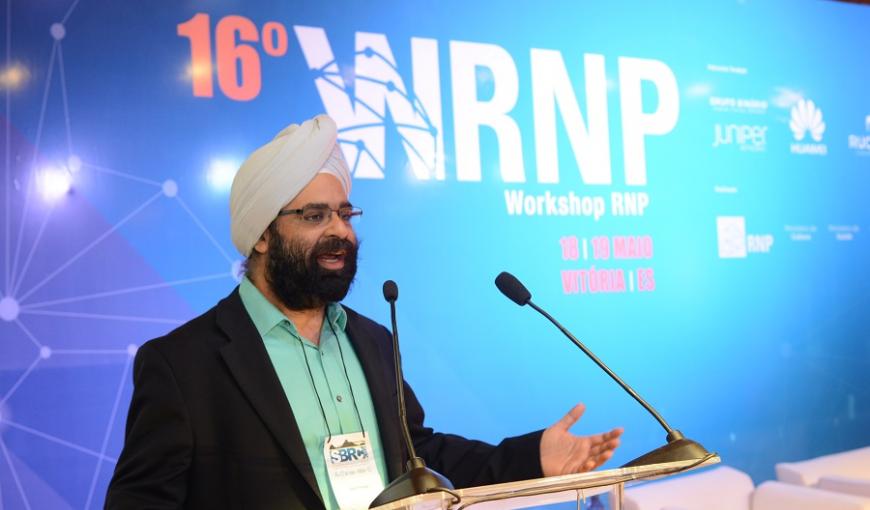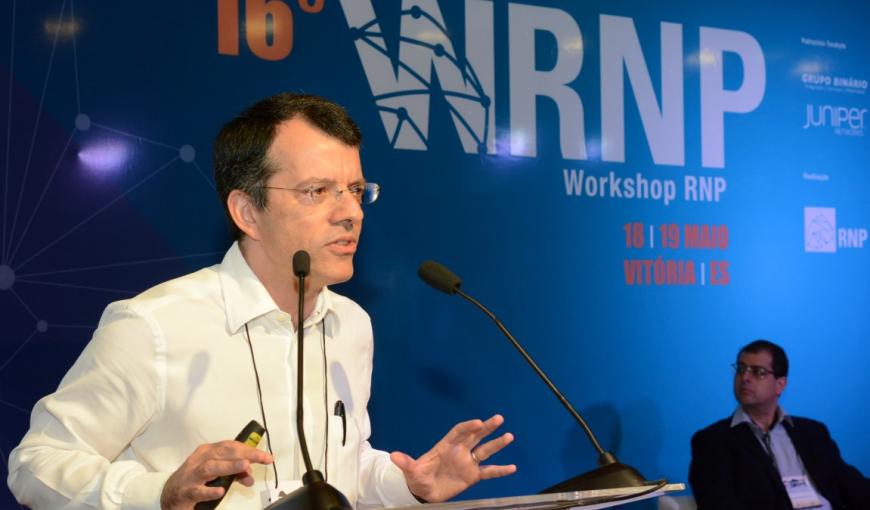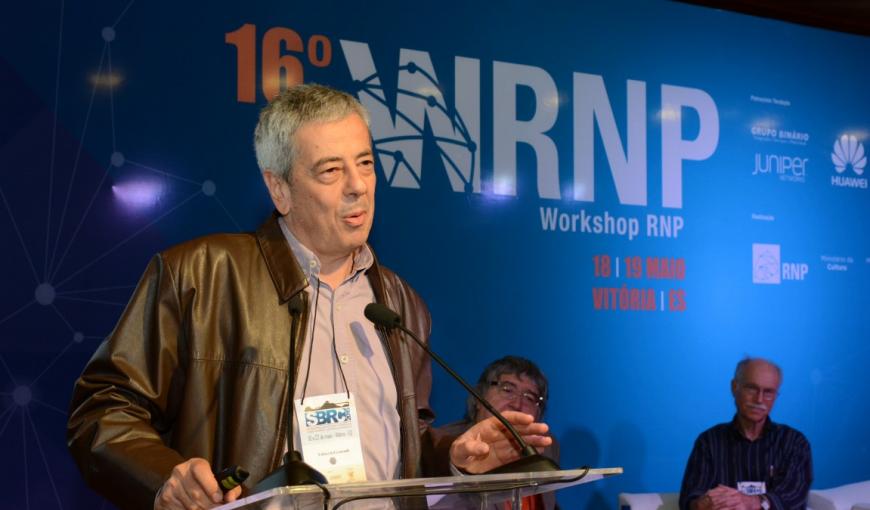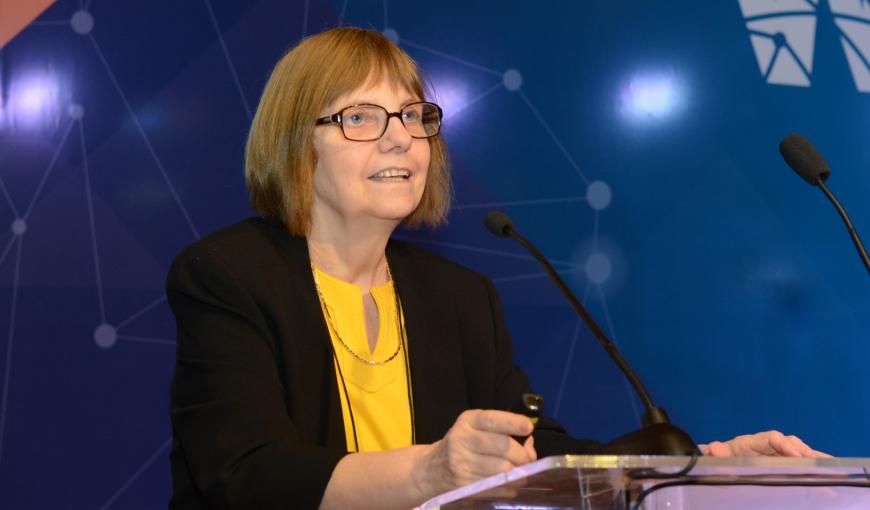16th WRNP
“Innovation is useless, unless real problems for real people are resolved”. With this statement, the US network ESnet Chief Technology Officer Inder Monga (picture 1) marked the first day of the 16th WRNP, which was held this week, in Vitória. The event gathered the research community in Information and Communication Technologies (ICT).
Inder Monga was guided by the question ‘Why innovate?’ and exposed how the traffic in the academic environment has evolved historically at a faster rate than the commercial Internet. He listed the characteristics of what must be the next network architecture. The redesign should stimulate greater interaction between the infrastructure and scientific applications.
The ESnet head proposed a new model for the improvement of the network flow and pointed as an alternative the Named Data Networking (NDN). It is a new type of architecture focused on content, which was indicated by its name and no longer by its physical location, defined by a network address. For the lecturer, the organizations that operate the academic networks need to “overcome software challenges”. Facing this, ESNet invests in a Software-Defined Networking (SDN) operationalization project, focusing on automation, analysis and assurance, aiming to offer operational support to this programmable platform.
Jeronomi Bezerra, from Florida International University, pointed SDN technology as the future of international academic collaboration. The Project Coordinator at AmLight, a network infrastructure comprised by four 10 Gb/s links between Miami, Brazil and Chile, stressed that SDN allows the network to be programmable at the virtualization layer. “The great advantage of these topologies is the mutual redundancy. If the network goes off on the SDN ring, the other MPLS ring takes over”, he commented.
Rooms for experimentation
Another highlight was the panels about constant advances on the identity management area. Identity Management Technical Committee (CT-GId) announced the new experimentation laboratory, GIdLab, which is aimed at researchers who want to test new authentication and authorization forms.
In the audiovisual area, the professor and founder of the Center for Research and Extension in Digital Video Applications of the Federal University of Paraíba (LAViD/UFPB) Guido Lemos talked about the Videocollaboration Committee, which aims to structure and study the future of the applications in various areas of research, development and innovation.
“We started last year, with the mapping of the installed research capacity in Brazil (...) and some of the themes that appeared were the evolution of video resolution, 3D, communication, security, telehealth and infrastructure. In the resolution area, we are living the same thing that happened to audio. We only stopped when we reached the limit of quality that the human hear is capable of noticing. The laboratories are working to reach the maximum the eye can capture, reaching a video reception standard where no one can differentiate between virtual and real”, he stressed.
Internet expansion
At the “A (better) Connected Country” panel, RNP General Director Nelson Simões (picture 2) defended the creation of new paths to interconnect Brazil to the world. “Today, the fiber infrastructure dedicated to education and research has a distribution that does not follow the logic of a very important collaboration like the one we have with Europe and Africa, for example. We only have an international connection with North America”, he stated.
Simões mentioned the goal to bring communication and collaboration infrastructures for the campi of federal university and institutes located in the countryside of Brazil. One of the partners in this action is the Brazilian Army, which is involved with RNP on the Connected Amazon program, which aims to provide optical fiber infrastructure for the riverside population with the launch of an underwater cable, in the tributary beds of the Amazon Basin.
According to the Army Integrated Telematics Center (CITEx) Chief, general Decílio Sales, the concept test of the underwater cable was conducted with the placing of fibers on a 10km stretch, on the Negro River, on April 7 and 8. The connection is working, since then, without presenting technical problems.
RNP Engineering and Operations Director Eduardo Grizendi (picture 3) brought the full panorama of academic network Ipê in another lecture. Currently, there are one thousand and two hundred campi connected to it, 50 own metropolitan infrastructures and 2,400 km of own metropolitan optical cabling.
He celebrated the recent activation of the fiber optic linkage in Amapá, the last to still be supplied by radio, and the improvement in the availability in the Northeast, due to the activation of circuits in partnership with Telebras. He also stated he intends to activate, by the end of 2015, the Rio-São Paulo-Brasília route at 100 Gb/s. “We will close the year with a ‘gigantized’ backbone”, he assured.
Integration of technologies in the classroom
Due to the urgency of greater integration and connectivity in the classrooms, the Federal University of Santa Catarina (UFSC) Professor Simone Biléssimo brought updated data about the teaching reality in the country: an average of computers of only 10.39% at schools and 55.70% of teaching institutions without computer laboratories. Experts presented remote experimentation tools that may be solutions for the lack of infrastructure and also to awaken the interest of the students.
Liane Tarouco (picture 4), full professor at the Federal University of Rio Grande do Sul (UFRGS), showed games resources, content generation and friendly interaction tools to stress the need to catch the student’s attention, distracted by stimuli such as social networks and WhatsApp. “People are not multitaskers, they are ‘multiswitches’. They switch from one stimulus to another, and they waste time and focus because of it”, she explained.
She highlighted the potential of pedagogical innovation and showed data that prove that “learning is essentially an active process. Our authoring tools have to help us generate content”, she concluded.
See the full coverage (in Portuguese) of the 16th WRNP on wrnp.rnp.br/noticias.



